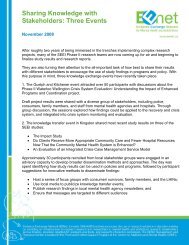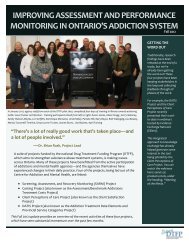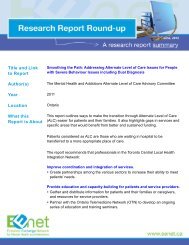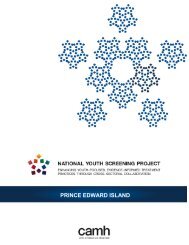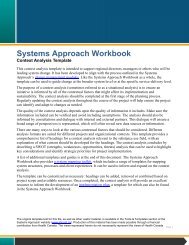Implementation of Early Psychosis Intervention Program ... - EENet
Implementation of Early Psychosis Intervention Program ... - EENet
Implementation of Early Psychosis Intervention Program ... - EENet
You also want an ePaper? Increase the reach of your titles
YUMPU automatically turns print PDFs into web optimized ePapers that Google loves.
32Standard 1: Facilitating Access and <strong>Early</strong> IdentificationThe survey examined the following elements in Standard 1:4. Developing an early identification/rapid response system5. Public education6. Access to translation and interpretation services1. Developing an early identification/rapid response systemStandard 1 indicates a role for EPI programs in identifying and supporting area providers andorganizations to assist with early identification and referral <strong>of</strong> individuals experiencing signs orsymptoms <strong>of</strong> psychosis. The premise is that primary care providers, school or university healthservices, youth agencies, mental health services and other organizations who regularly connectwith youth and young adults have the potential to recognize signs and symptoms <strong>of</strong> psychosis,make timely referrals to EPI programs for assessment, and assist in engaging the individual. EPIprograms use a variety <strong>of</strong> strategies to build and strengthen an <strong>Early</strong> Identification/RapidResponse network in their communities.Summary <strong>of</strong> Results:o Overall, programs indicated lower levels <strong>of</strong> implementation <strong>of</strong> this element than for otherStandard elements, with only 40% <strong>of</strong> sites able to implement this element ‘most <strong>of</strong> the time.’o Developing and sustaining an early identification and referral network was challenging forEPI services regardless <strong>of</strong> whether the program was larger or smaller, or hospital orcommunity agency based. Challenges pertained to having time, getting access to audiences,maintaining persistent outreach.o <strong>Implementation</strong> may benefit from local or regional support (e.g., for outreach to areaproviders, development <strong>of</strong> educational resources), and from having a plan in place forimplementing and monitoring this work.o <strong>Program</strong>s reported some conflict with implementing this element. Outreach requires havingthe capacity to accept new referrals, and can be problematic if the program is operating atcapacity already. In addition, programs are expected to respond quickly to referrals and arenot supposed to keep a waitlist.



